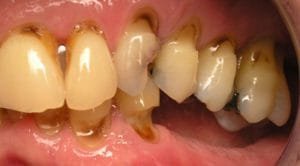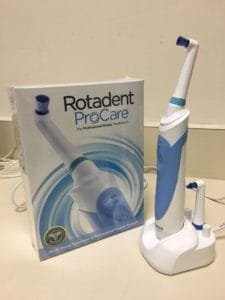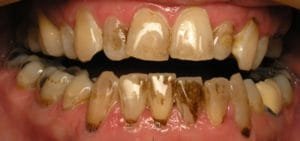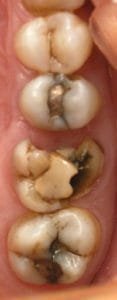 What is a Tooth Cavity?
What is a Tooth Cavity?
Dental cavities are a common dental problem. “Almost everyone will have a cavity at some point in their life,” explains Dr. Eslampour at Platinum Dental, Inc. in San Marcos. Dental cavities can start in different parts of a tooth, like on the chewing surface or between the teeth. At other times, the tooth decay can start at the gum line on the tooth’s root. No matter where the cavity begins, they all start the same way and destroy the tooth. In this article, we’ll talk about how cavities develop. We’ll also look at how you can prevent dental cavities and what to do if you think you have a tooth cavity.
How Do Cavities Form?
How do we get a tooth cavity? Are they painful?
 A dental cavity does not form overnight. It develops over several nights, per se. And depending on your pain tolerance, it may cause no discomfort up to severe pain. Some people wonder if cavities are hereditary. And the answer is no. What is hereditary are those genetic codes responsible for tooth, gum, and enamel formation. The main ingredient necessary for a dental cavity to start is plaque. The second most consequential factor is exposure time to plaque. So the next question to ask is what is plaque?
A dental cavity does not form overnight. It develops over several nights, per se. And depending on your pain tolerance, it may cause no discomfort up to severe pain. Some people wonder if cavities are hereditary. And the answer is no. What is hereditary are those genetic codes responsible for tooth, gum, and enamel formation. The main ingredient necessary for a dental cavity to start is plaque. The second most consequential factor is exposure time to plaque. So the next question to ask is what is plaque?
Tooth Cavity – Plaque Required
What is “plaque?” If you haven’t brushed your teeth recently, gently scrape the surface of one of your back teeth with one of your fingernails. You’ll see a whitish gooey layer that collects under your nail. And that is plaque. Plaque contains the necessary fuel for cavities to begin developing.
As a biological organism, we have different kinds of “bacteria” in our body naturally. Their presence allows our body to function correctly. Some bacteria are harmful to us, especially if their numbers grow beyond our bodies’ capacity to counter their harmful effects. The bacteria responsible for the actual formation of the tooth cavity uses the plaque as its energy source. This process leads to the release of acids by the bacteria onto the tooth surfaces. It is this acid that starts chipping away at the tooth. The acid is a chemical assault, and it takes time for the damage to become noticeable.
Plaque sticks to everything, like our tongue, cheeks, and gums. And, of course, plaque sticks to the teeth. Usually, plaque gets stuck to the outer layer of the tooth, which is covered by enamel. But it can also stick to the root of the tooth, which is not covered by enamel and is a lot more prone to tooth decay.
So now that we have a better picture of how a tooth cavity forms, let us talk about how to prevent them from developing in the first place.
Dental Cavities – Prevention
Prevention of dental cavities doesn’t have to be a chore. It’s all about taking little steps to minimize the damage associated with certain foods. Some people equate cavities with giving up sweets and what they enjoy eating. But that is not the goal of prevention. We can enjoy what we want to eat (sweets included) and still prevent cavities too.
Good Oral Hygiene
To get a tooth cavity, the plaque needs to be in contact with the tooth surface for extended  periods, repeatedly. Meaning that if you clean your teeth properly in between meals and snacks, you’re less likely to get a cavity. And this is the main reason our dentist always recommends daily flossing (once) and brushing (twice). Electric toothbrushes (like the Rotadent) are more effective in removing plaque than a regular toothbrush. We also recommend fluoride kinds of toothpaste and rinses, which boost the fight against dental cavities. It would also help to have your teeth cleaned professionally at least twice a year. There are parts of your mouth that collect more plaque and are difficult for you to clean effectively.
periods, repeatedly. Meaning that if you clean your teeth properly in between meals and snacks, you’re less likely to get a cavity. And this is the main reason our dentist always recommends daily flossing (once) and brushing (twice). Electric toothbrushes (like the Rotadent) are more effective in removing plaque than a regular toothbrush. We also recommend fluoride kinds of toothpaste and rinses, which boost the fight against dental cavities. It would also help to have your teeth cleaned professionally at least twice a year. There are parts of your mouth that collect more plaque and are difficult for you to clean effectively.
Avoid Nibbling on Sweets
Enjoy your sweet treat, whatever it may be. But don’t nibble on it for hours on end.  Also, avoid biting and squeezing your teeth into chewy and sticky candy. These types of sweets are more likely to cause physical damage to the tooth. Instead, let them soften up with your saliva and melt away in your mouth. Afterward, be sure to rinse your mouth out with water, preferably alkaline water. The reason is you want to reverse the damage caused by the acidic environment after eating the sweets. And at the very least, you want to wash off the acidic layer left on the teeth if you don’t have alkaline water.
Also, avoid biting and squeezing your teeth into chewy and sticky candy. These types of sweets are more likely to cause physical damage to the tooth. Instead, let them soften up with your saliva and melt away in your mouth. Afterward, be sure to rinse your mouth out with water, preferably alkaline water. The reason is you want to reverse the damage caused by the acidic environment after eating the sweets. And at the very least, you want to wash off the acidic layer left on the teeth if you don’t have alkaline water.
Minimize Soda and Juices
If you want to have a soda or a sweet beverage, it’s not the end of the world. But understand that it’s best to avoid these altogether. However, we are all humans. And we want to enjoy life. Have your soda or juice with your meal. Don’t keep sipping on it in between meals. Sodas and various other “health” beverages are quite detrimental to our teeth and bones in the long run.
Good Saliva
Our saliva plays a vital role in the fight against cavities. And specifically, having enough of it is the key.  As the saliva washes over and bathes our teeth, it is continually helping re-strengthen the tooth at a chemical level. At the same time, it helps dissolve the plaque on the teeth and wash it off. However, some people don’t have enough saliva and don’t know it. If your mouth is usually dry, you have a higher risk of developing tooth cavity than if your mouth is generally moist. There are many reasons why some people don’t produce enough saliva. Medications, age, genetics are just a few reasons. The best way to combat dry mouth is always to have a bottle of water to sip on. Ideally alkaline water, but at least neutral in pH. There are also some over the counter rinses tailored for people with dry mouth. If necessary, the dentist can also prescribe other medications to help combat dry mouth symptoms.
As the saliva washes over and bathes our teeth, it is continually helping re-strengthen the tooth at a chemical level. At the same time, it helps dissolve the plaque on the teeth and wash it off. However, some people don’t have enough saliva and don’t know it. If your mouth is usually dry, you have a higher risk of developing tooth cavity than if your mouth is generally moist. There are many reasons why some people don’t produce enough saliva. Medications, age, genetics are just a few reasons. The best way to combat dry mouth is always to have a bottle of water to sip on. Ideally alkaline water, but at least neutral in pH. There are also some over the counter rinses tailored for people with dry mouth. If necessary, the dentist can also prescribe other medications to help combat dry mouth symptoms.
Sealants
Ask your dentist if dental sealants are right for you. Sealants are preventative micro-fillings placed on the teeth with deep grooves. While mainly advocated for children, there is no reason that adults won’t benefit from them.
Visual Check
You also want to look at your teeth in the mirror periodically. It is best not to ignore a stained or discolored tooth as it could be an early sign of a cavity. So what are some other signs of a tooth cavity other than pain?
For an easy to read article on treating this medical condition, visit the American Dental Association.
Cavities – How Do You Know You Have One?
What are some signs of tooth cavities? Stained or discolored teeth are the main ones. Another sign is a foul odor coming from the mouth, no matter how well you brush or what mouth rinse you use. Getting food stuck where it didn’t stick before is yet another sign. Tooth cavity destroys the structural integrity of a tooth. And as the tooth slowly breaks down, it leaves room for food to get packed in there. Drifting teeth is another symptom. Teeth hold each other in place. When one starts to break down due to a cavity, the adjacent teeth can drift into the newly vacated space.
A sensitive tooth is another sign of possible tooth decay. Before a tooth starts hurting, it may cause sensitivity for a while. And as the decay progresses and gets bigger, that’s when the sensitivity turns into outright pain. Sensitivity or pain to sweets, temperatures, and chewing are other telling signs of a cavity.
Another sure way to tell if you have a cavity is to visit your dentist. At Platinum Dental, Inc., we recommend dental visits at least twice a year. Our family dentist checks your teeth and also X-rays them to find any hidden cavities. Our dentist can find and repair even a small decay without too much trouble. And as our dentist explains, it is best to take care of a cavity when it’s small. Waiting to get it fixed can only make it more complicated. So what happens if you don’t repair a small cavity?
Cavities – Gone Wild!
A dental cavity can start on the tooth’s chewing surface, between the teeth, or on the tooth’s root. Root cavities pose a greater risk to the health of the tooth for two reasons. First, most dental bonding agents are designed to be used on enamel. The root has a different chemical makeup. Some bonding agents may not work as well, while others may cause sensitivity afterward. The second reason is that a root cavity grows faster than one on the tooth, leading to more damage in a shorter period. And since the nerve that runs inside the root is not too far away, a root cavity can easily extend into the nerve.
 Symptoms of tooth cavity
Symptoms of tooth cavity
Cavities always start small, whether on the tooth or its root. In most cases, they don’t cause any pain or discomfort. Some people may experience cold or sweet sensitivity at worst. These are the types of dental cavities that your dentist finds during your routine visits because you may have no pain or discomfort from the cavity yet. At this stage, fixing the tooth is simple and straight forward. Usually, dental bonding will take care of the issue at this stage.
As the cavity grows more extensive, the bacteria will infect the “live” part of the tooth (the dentin under the enamel). At this stage, the cavity usually hurts, and there may even be a hole in the tooth. Fixing the tooth is still possible, but it may have suffered irreversible damage due to the large cavity. In cases of nerve damage, a root canal is the only option. While not impossible to treat teeth with a root canal and a crown, it was avoidable.
In cases where the cavity gets too large, the tooth may be deemed hopeless. At this stage, there isn’t much to be done in the way of fixing the tooth. The only option is to remove the tooth as the infection is out of control. A dental implant can replace the lost tooth. The better option would have been to fix the cavity before it got too extensive.
As our dentist explains, it takes time for a cavity to cause severe damage. Regular dental visits eliminate this risk as your dentist can detect even a small cavity. Plus, who doesn’t like visiting their dentists?
Cavities – Good News
Can you use the terms “cavities: and “good news” in the same text? Yes. The good news is we can repair cavities with natural-looking and long-lasting results. Dental bondings have made the ugly (and biologically hazardous) silver fillings a thing of the past. A practical home dental hygiene routine is key to long term success. And there are tools to make your life easy. An electric toothbrush like the Rotadent makes plaque removal more efficient. Various flossing tools make this essential task do-able. Home fluoride is also available for patients in need. At Platinum Dental, Inc., our doctor is always educating the patients on protecting their teeth against cavities and gum disease. This way, our patients will be able to keep their mouths and smiles healthy for a lifetime. If you need to make an appointment or if you have a question, you can always contact us here, send an e-mail or give us a call at (760) 510-9009.
 What is a Tooth Cavity?
What is a Tooth Cavity? Symptoms of tooth cavity
Symptoms of tooth cavity